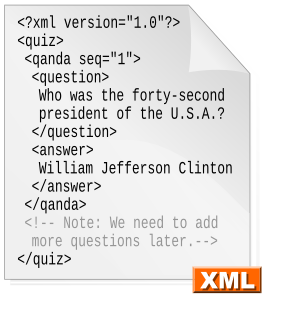A PrintableString is a restricted character string type in the ASN.1 notation. It is used to describe data that consists only of a specific printable subset of the ASCII character set.

In computer programming, a string is traditionally a sequence of characters, either as a literal constant or as some kind of variable. The latter may allow its elements to be mutated and the length changed, or it may be fixed. A string is generally considered as a data type and is often implemented as an array data structure of bytes that stores a sequence of elements, typically characters, using some character encoding. String may also denote more general arrays or other sequence data types and structures.
Abstract Syntax Notation One (ASN.1) is a standard interface description language for defining data structures that can be serialized and deserialized in a cross-platform way. It is broadly used in telecommunications and computer networking, and especially in cryptography.
In mathematics, a set A is a subset of a set B, or equivalently B is a superset of A, if A is contained in B. That is, all elements of A are also elements of B. A and B may be equal; if they are unequal, then A is a proper subset of B. The relationship of one set being a subset of another is called inclusion or sometimes containment. A is a subset of B may also be expressed as B includes A, or A is included in B.
According to the ASN.1 Specification of basic notation, [1] the character set of PrintableString can be expressed as:
| Name | Graphic |
|---|---|
| Latin capital letters | A,B, ... Z |
| Latin small letters | a,b, ... z |
| Numbers | 0,1, ... 9 |
| SPACE | (space) |
| APOSTROPHE | ' |
| LEFT PARENTHESIS | ( |
| RIGHT PARENTHESIS | ) |
| PLUS SIGN | + |
| COMMA | , |
| HYPHEN-MINUS | - |
| FULL STOP | . |
| SOLIDUS | / |
| COLON | : |
| EQUALS SIGN | = |
| QUESTION MARK | ? |
The PrintableString definition does not include the at sign (@) or ampersand (&). This sometimes causes problems for naive implementers who attempt to put an SMTP email address into an X.509 digital certificate Distinguished Name.
The at sign, @, is normally read aloud as "at"; it is also commonly called the at symbol or commercial at. It is used as an accounting and invoice abbreviation meaning "at a rate of", but it is now most commonly used in email addresses and social media platform handles.
The ampersand is the logogram &, representing the conjunction "and". It originated as a ligature of the letters et—Latin for "and".
An email address identifies an email box to which email messages are delivered. A wide variety of formats were used in early email systems, but only a single format is used today, following the specifications developed for Internet mail systems since the 1980s. This article uses the term email address to refer to the addr-spec defined in RFC 5322, not to the address that is commonly used; the difference is that an address may contain a display name, a comment, or both.
The PrintableString definition does not include asterisk (*) which means it must not be used to represent a wildcard in an X.509 digital certificate Distinguished Name.
An asterisk (*); from Late Latin asteriscus, from Ancient Greek ἀστερίσκος, asteriskos, "little star", is a typographical symbol or glyph. It is so called because it resembles a conventional image of a star.
In cryptography, X.509 is a standard defining the format of public key certificates. X.509 certificates are used in many Internet protocols, including TLS/SSL, which is the basis for HTTPS, the secure protocol for browsing the web. They are also used in offline applications, like electronic signatures. An X.509 certificate contains a public key and an identity, and is either signed by a certificate authority or self-signed. When a certificate is signed by a trusted certificate authority, or validated by other means, someone holding that certificate can rely on the public key it contains to establish secure communications with another party, or validate documents digitally signed by the corresponding private key.



